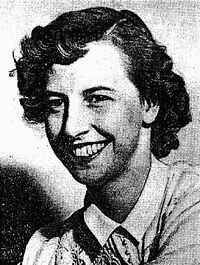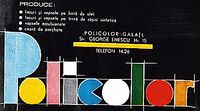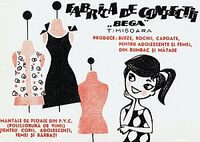Advertising in Gylias
Advertising in Gylias is a uniquely stigmatised and restricted industry compared to the Tyranian average. Gylias has some of Tyran's most draconian restrictions on advertising, and what advertising exists has had to adapt to Gylias' market socialist economy and culture.
History
Pre-modern advertising
Commercial messages date back to the Liúşai League, particularly in the form of graffiti and wall paintings. Trademarks later emerged as products began to be accompanied by particular images or seals to identify the manufacturer. Wealthy citizens were expected to provide patronage to temples, the arts, and communal festivals and feasts.
Advertising was stifled under Xevden, where the immiseration of the native populations blunted its reach and impact. By the 19th century, advertising was strongly bifurcated:
- Advertising aimed at Xevdenite elites tended to be ostentatious, characterised by conspicuous consumption, and reflecting the anxieties of the elite during Xevden's disintegration.
- Advertising aimed at Gylians tended to be straightforward and informative. It was shaped by the Gylian ascendancy, and reflected the parallel society that Gylians constructed outside the Xevdenite state. A strong honour system was used to combat false advertising and quackery.
Alscia
Advertising experienced accelerated development in Alscia. For many Gylians, the "hurried province" marked the first experience of industrialisation, modernisation, and widespread prosperity, an element which was reflected in its advertising.
The main medium of advertising was newspapers and magazines. The Etra Echo and The Senik Sun, the two largest newspapers, pioneered the use of advertising in print, employing both conventional advertising and classified advertising.
Alscian advertising tended to reflect the spirit of the "hurried province"; the egalitarian aspect was especially noticeable in clothes adverts. Gaulette, Alscia's largest conglomerate, sought to position itself as a national champion, capitalising on protectionist themes. Famous Alscians like Adela Stein, Olivia Dafi, and Cécile Sorel endorsed local products and appeared in advertising campaigns.
The distinctive style of advertising that emerged in Alscia, shaped by the popularity of Art Nouveau and Art Deco, was later nicknamed Pubblicità all'italiana ("Italian-style advertising"), reflecting the Italian cultural influence of the times.
Free Territories
The Liberation War was another crisis period after the relative boom of Alscian times. Advertising was forced to adapt to the wartime rationing, shortages, and anarchist reorganisation of the Free Territories.
Print advertising was forced to shift towards classified advertising. Adverts now mainly served to organise the vast supply and social services network built by the Free Territories, with information provided about local cooperatives, community markets, clinics, educational facilities, sports clubs, and other support groups. The journalist Luisa Braglia described print adverts in the Free Territories as "mundane poetry" and "the blooming seeds of a new social order".
Although the Alscian atmosphere of widespread prosperity was gone, advertising was still mobilised in the service of prefigurativism and utopian socialism. Many publications continued to include Pubblicità all'italiana illustrations in their pages, although now without accompanying copywriting, out of habit. Their persistence reflected the perseverance of the Free Territories and served as a foundation for Gauchic art.
The Free Territories represented the golden age of radio, and accordingly, radio advertising became a significant medium. Since radio stations were run by volunteers, commercial broadcasting was non-existent and sponsorship was ostracised. Radio adverts functioned much like in print: mainly informative and public interest-oriented, announcing upcoming events and important services and trade.
Independence

The wartime transformation was cemented by the new regulatory regime implemented starting in 1958.
The Office for Public Protection Against Advertising (OPPAA) was created as the administrative agency responsible for regulating advertising. Its name reflected the strong suspicion of advertising that had developed in the Free Territories. There had been debates whether to ban advertising entirely, but ultimately the Law on Freedom and Fairness in Information of 1962 mandated restrictions and separation from reporting.
The first head of the OPPAA, Sara Nielsen, had a fundamental role in reshaping Gylian advertising. She detested advertising, particularly its use of psychological manipulation. She brought in a draconian code of regulation, which included a prohibition on billboards, direct marketing, and "memorable" advertising. She gave the OPPAA an entirely proactive role, forcing all adverts to be submitted for approval before publication or broadcast. The complementary work of the Information Bureau and National Broadcasting Office reinforced the system.
Advertising as conventionally understood was thus largely smothered and subsumed by the Golden Revolution. Gauchic had evolved into the dominant style of visual art and completely shed the commercial aspects of its antecedents, although foreign audiences during the Gylian Invasion could notice its resemblance to advertising art. Gauchic illustrations in the printed media usurped the role of advertising, fulfilling instead the role of public service announcements and social engineering.
Numerous organisations seized the public sphere formerly taken by commercialism with their public service announcements and promotion of the Golden Revolution. Some of the more notable and prolific of these were the Revolutionary Communications Office, Institute for the Protection of Leisure, National Recreation Organisation, Agricultural Produce Marketing Board, Arts Council, National Heritage Board, Directorate of Nature Protection, National Parks and Reserves Bureau, Deposit Return Administration, and National Travel Administration.
New dominant themes came to include refusal of work, reduction of working time, conservation, and avoidance of waste, in particular due to the influence of the Institute for the Protection of Leisure and the National Obligation period. Virginia Inman writes in The Power of Glamour that many of the gauchic illustrations functioned as "productless adverts", promoting instead the notion of "socialised luxury" itself and providing attractive utopian models for building a new society.
Certain models like Isabel Longstowe, Jane Russell, and Sima Daián achieved widespread popularity and a pervasive daily presence due to what Virginia considers their abiility to appear as either "glamorous everywomen" or "glamorous representatives of ideals", depending on the context. Sima was known for her success at practicing a form of personal branding, gathering together her photographs into popular photobooks, and capitalising on her fame to become an influential theorist of aristerokratia together with Ser Şanorin. Electra Galanou similarly used her modeling work to complement her entrepreneurial activities with the Omicron Group, her glitzy product launches being an inventive workaround for the OPPAA's regulations.
The OPPAA was highly successful at proscribing and restricting Gylian advertising. Classified advertising was limited mainly to regional and local newspapers, with most federal newspapers and magazines not accepting advertising. Gylian Radio and Gylian Television maintained a complete ban on advertising, not even playing songs that mentioned products in their lyrics. Television adverts were practically non-existent, with their place taken by quirky and innovative bumpers and interstitials. Thus, Keie Nanei argues that "generations grew up after 1958 never having experienced capitalist advertising", and it became a common cause of culture shock for Gylians traveling abroad.
Recent developments
Gylias' participation in the Common Broadcasting Union made it the intransingent voice opposed to any kind of commercialisation of the CBU. The establishment of MTV helped popularise music videos, which were accepted in Gylias as an art form rather than commercials for their respective songs.
The danger of the Gylian consensus fraying in the wretched decade and the shock of the neoliberal conspiracy and dérive au droite caused a backlash. The Mathilde Vieira government in the 1990s strengthened regulations and expanded the OPPAA's jurisdiction to include the internet.
The upcoming end of the GNBS' federal broadcasting monopoly prompted some apprehension, and the National Broadcasting Office made the "no advertising" rule official for any private channel seeking a federal broadcast license.
Where regulations had previously focused on advertising itself, the government carried out the final move in the 1990s by also mandating plain packaging for all products distributed in Gylias (with the exception of cultural works).
Context

Gylian advertising operates in a singular context, due to the impact of stigma against its capitalist manifestations and the economy as a whole. The strong degree of planning in the economy, in particular the National Prices Board's sole responsibility for prices, and the cooperativisation of the economy, prevents manufacturers from competing on prices or engaging in cut-throat tactics.
The OPPAA regulations on advertising have been cited by several commentators as the most draconian in Tyran, short of banning advertising entirely. The most famous provision bans adverts from being "memorable" — which automatically prevents jingles and advertising slogans, as well as overt sponsorship.
Advertising restricted products such as drugs, alcohol, guns, as well as public monopolies like pharmaceuticals, is completely banned.
The average Gylian advert, whether print or broadcast, is thus purely informative: listing the name of the company, the products it makes, and often its address and contact details. Most companies treat advertising as a "necessary evil", and are even wary of including any details beyond the basic information and illustrations of their products, due to the risk of the OPPAA rejecting the advert for being "memorable" and thus providing an unfair competitive advantage.
An interesting casualty of the regulatory regime has been film trailers. Trailers are practically absent from Gylian cinema due to various difficulties: strict laws against puffery that prevent conventional film promotion, the concern about violating the OPPAA's ban on "memorable" advertising, and the difficulty of using film footage in a purely informative manner. Instead, filmmakers are more likely to focus on film posters, which can be easily passed off as artistic works complementing a film rather than a product advertising them. Another popular method is to produce shorts starring the characters themselves presenting their film in-character, which allows their classification as shorts rather than adverts.
Gylian–Tennaiite actress Simone Kalpita pointed out the cultural gap between the two in interviews, recalling that while she worked openly on television commercials in Tennai, her television work in Gylias was stubbornly classified as short films instead, as a way to secure more artistic space than the OPPAA's advertising regulations allowed.
Types

Print advertising
Classified advertising is generally used in regional and local publications, where it is judged appropriate to the local context.
The overwhelming majority of federal publications refuse to accept advertising.
Although direct marketing is banned, mail order is allowed through catalogues and specialised publications.
Broadcast advertising
Station identification, bumpers and interstitials are the most commonly accepted forms of advertising on radio and television, since they function mainly as self-identification and programming.
Advertising is accepted to some extent by regional, local, and community broadcasters — the majority being non-profit, advertising thus serves an informative rather than promotional purpose. Most broadcast adverts follow the information-focused model of print.
Internet advertising
Most forms of online advertising are banned due to the application of the OPPAA regulations to the internet in Gylias. Digital display advertising is particularly frowned upon and blocked by default in Gylian web browsers.
NetStream moderators are notable for removing adverts uploaded to the service, except those used in a historical context, for commentary or transformative purposes, or parody.
Outdoor advertising
While billboards are banned, putting up posters and using street art for advertising are legal and common. The Constitutional Court has ruled that posters and graffiti do not violate the right to privacy as they are one part of the implied "public forum", and thus exist as part of a broader "public discussion" and are open to criticism, rebuttal, or mockery.
Adult advertising
Sex work and pornography are advertised in the same way as other services.
The Union of Sex Workers has notably won several victories in seeking exemptions from overly strict OPPAA standards, with the Constitutional Court ruling that strict enforcement violated sex workers' right to equality as per Article 12 of the Constitution, and recognising slogans characterised by bawdy humour as a fundamental part of the occupation, protected as "public expression" rather than promotion.
Foreign advertising in Gylias
Strict regulations on advertising reinforce the Gylian economy's strong domestic focus, and pose a significant obstacle for foreign companies.
Some foreign products that have achieved the Gylian breakthrough, such as Marlene Amberg AmbA clothing or Amul milk, have resorted to commissioning short animations or video games starring their mascots as a way to build a profile without falling afoul of OPPAA regulations. This approach has increased in importance after the adoption of universal plain packaging for all products distributed in Gylias.